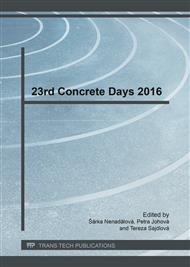p.178
p.184
p.190
p.198
p.203
p.209
p.215
p.221
p.227
Analysis of the Overall Reliability Slender Concrete Columns
Abstract:
Standard for designing of concrete structures STN EN 1992-1-1 offers three methods of analysis of second order effects with axial load. Namely, a general method based on non-linear second order analysis and two simplified methods: Method based on nominal stiffness and method based on nominal curvature. According to three series of the experiments of slender concrete columns and after calibration of the non-linear calculations, the authors in following paper compare the global reliability of above mentioned design methods with parametric study. According to executed research is possible to say that the differences in reliability of the design methods are considerable in several cases of the slender concrete columns design.The experiments were executed in the Central laboratory of Faculty of Civil Engineering STU in Bratislava in cooperation with company STRABAG ltd. The series of columns differed only in strength class of concrete (C45/55 for S1, C70/85 for S2, C80/95 for S3) and each series included six tested samples. The geometry and reinforcement of the columns as well as the initial eccentricity of the axial force were design so, that the buckling failure of the columns occurred earlier than the design strength of materials in the most stressed cross-section ran out.
Info:
Periodical:
Pages:
203-208
Citation:
Online since:
May 2017
Authors:
Keywords:
Price:
Сopyright:
© 2017 Trans Tech Publications Ltd. All Rights Reserved
Share:
Citation:


